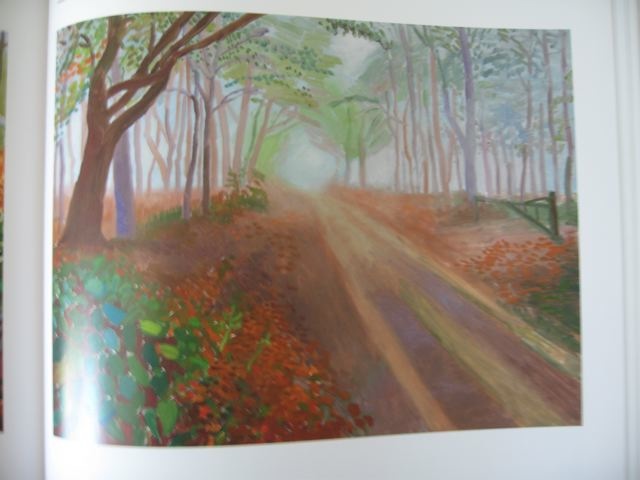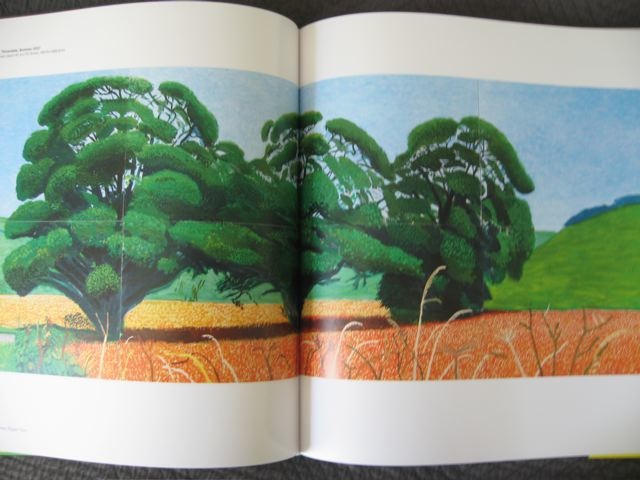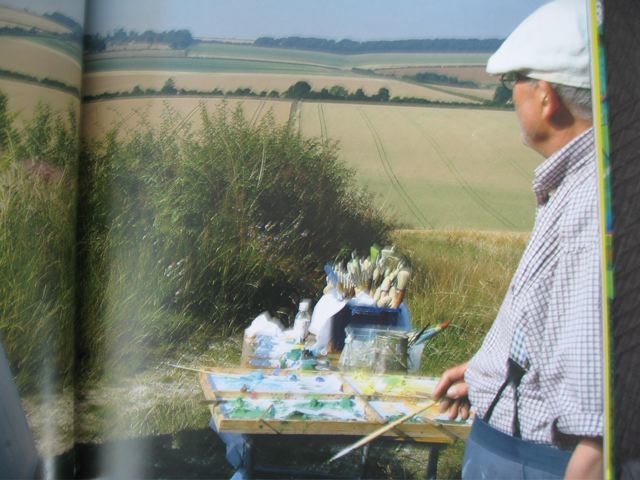I finally got my book in the mail, which I had ordered over a month ago, on the current Hockney exhibit at the Royal Academy in London, David Hockney, A Bigger Place. It was well worth the wait.
The book is huge and has gorgeous color reproductions. I had seen a few of the early works from his Yorkshire landscape series in 2006 when My Beloved Brit and I were in London and tracked them down at the Annely Juda Fine Art in London. I had read an article about how Hockney had returned “home” after years of success in LA. His dear friend Jonathan Silver was in the last stages of terminal cancer and these early landscapes came from the drive Hockney made back and forth from his mother’s home in Bridlington to his friends bedside in Wetherby.
We were blown away by the show at Annely Juda and these photos seem to do that earlier view justice.
It is fascinating that what I saw 5 years ago was the beginning of this new wave of pictures. We had seen his first efforts of the brightly colored rural landscapes, and I studied how he did multiple panels, something I was starting to explore.
The book helps explain what went on in those 5 years with the development of this work, and how this truly expansive and intriguing collection was born. I poured over the pages of sketches that preceded the actual paintings.
And am still going back to look at the full paintings again and again.
The book has a wealth of visual and written information on how the work formed.
It also helped me to understand how he approached his subject matter, as here where he studied the same three trees in different seasons, and in different mediums.
The book is organized similar to the show at the Royal Academy itself, from what the introduction claims. This exhibition is placed in series by subject, much as I have always organized my own work. I can understand finding an intriguing subject and going back to it again and again over time. So where I have “waves” and “branches” and “encounters”, Hockney has “Hawthorn Blossoms”, “Tunnels” and “Winter Timber and Totems”.
And as glorious as the color reproductions are, some of my favorite work is the black & white pieces…
But beyond the pure joy of seeing the art, the book is rich in its editorial content.
There is a great discussion of Hockney’s love hate relationship with the use of photography and new technology in aiding the artistic process, versus the choice of painting directly from nature. It supports a better understanding of how Hockney has struggled with the strategy of approaching the landscape, something I have found personally to be a challenge as well.
And we hear from the artist himself about his anticipation to the actual show. He knew for some time before hand that he would have the space, and worked with that in mind. This is a layout of the room that held his iPod pieces, an amazing work comprising 51 iPad drawings and a very large painting. As he says in the Preface “All are new, and would not have been conceived without the offer of the Royal Academy’s splendid rooms.”
I am only part of the way through the reading material, although I have studied the reproductions of the art several times already. At the moment my favorite essay is about returning to the landscape of youth, and Hockney’s ability to find a new motif for his art in his roots. The joy Hockney has in re-discovery of his boyhood haunts is compelling. He confirms what I long suspected. Life is always a new adventure.
I have many art books, with pages and pages of gorgeous color reproductions. But I must say, this is one of my favorites for the content and editorial. It is so layered with interesting material, both visual and the written word. I will read it cover to cover.














